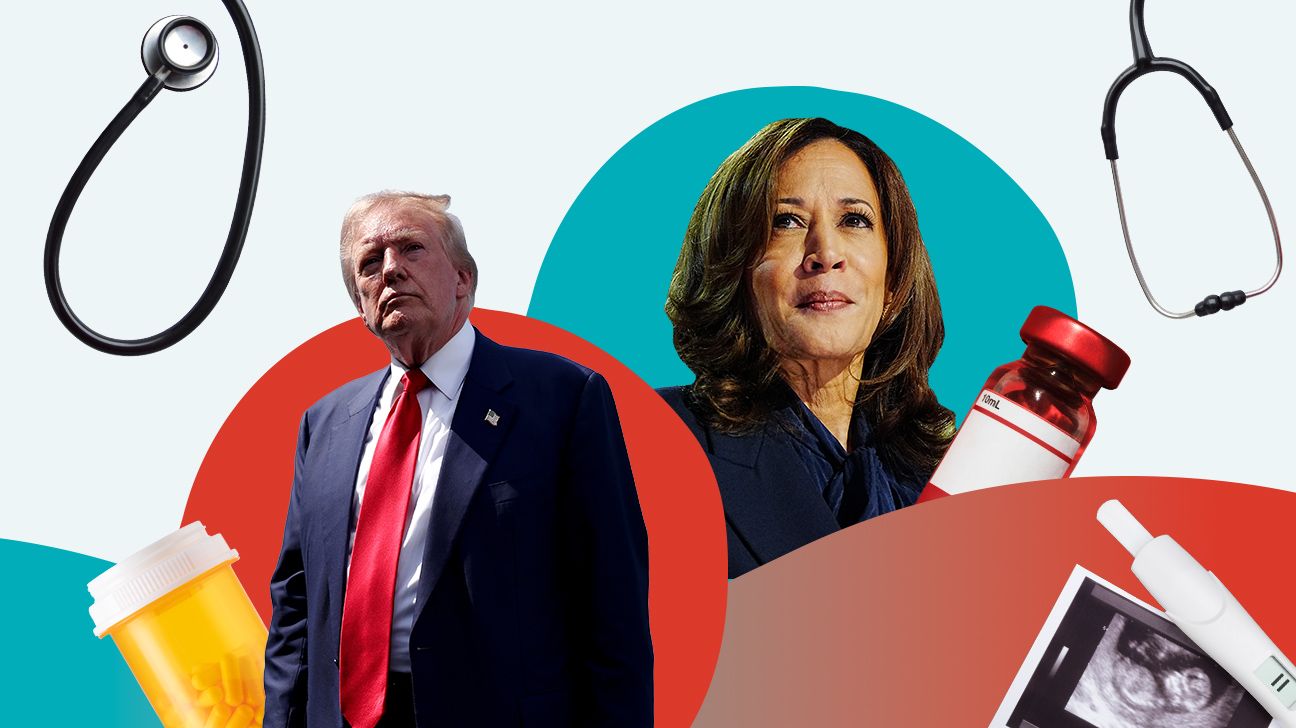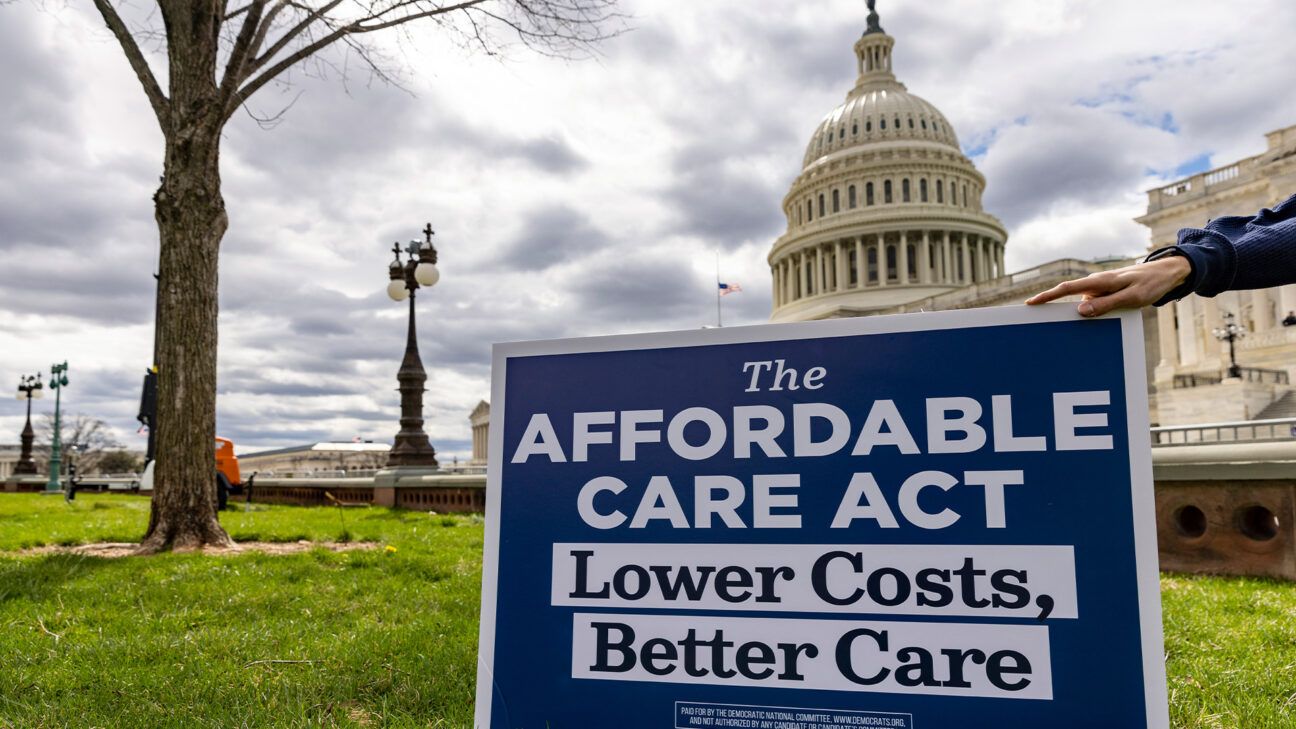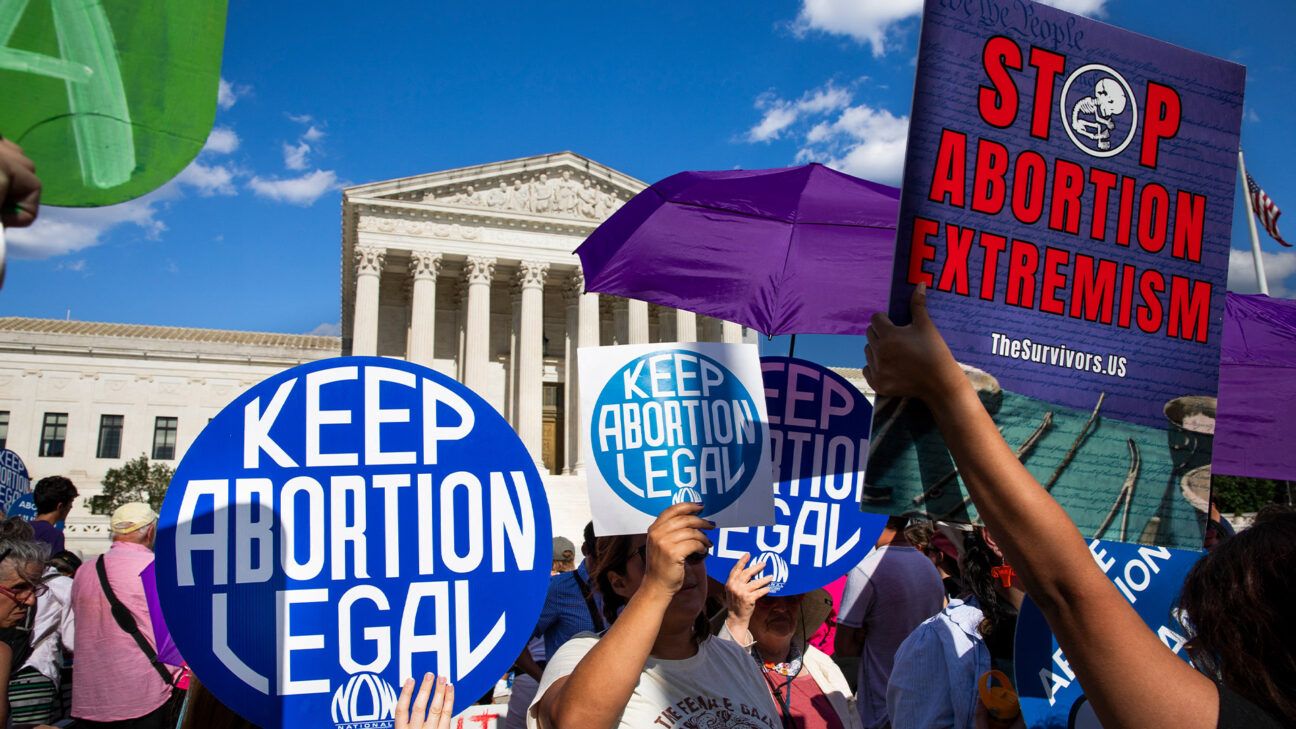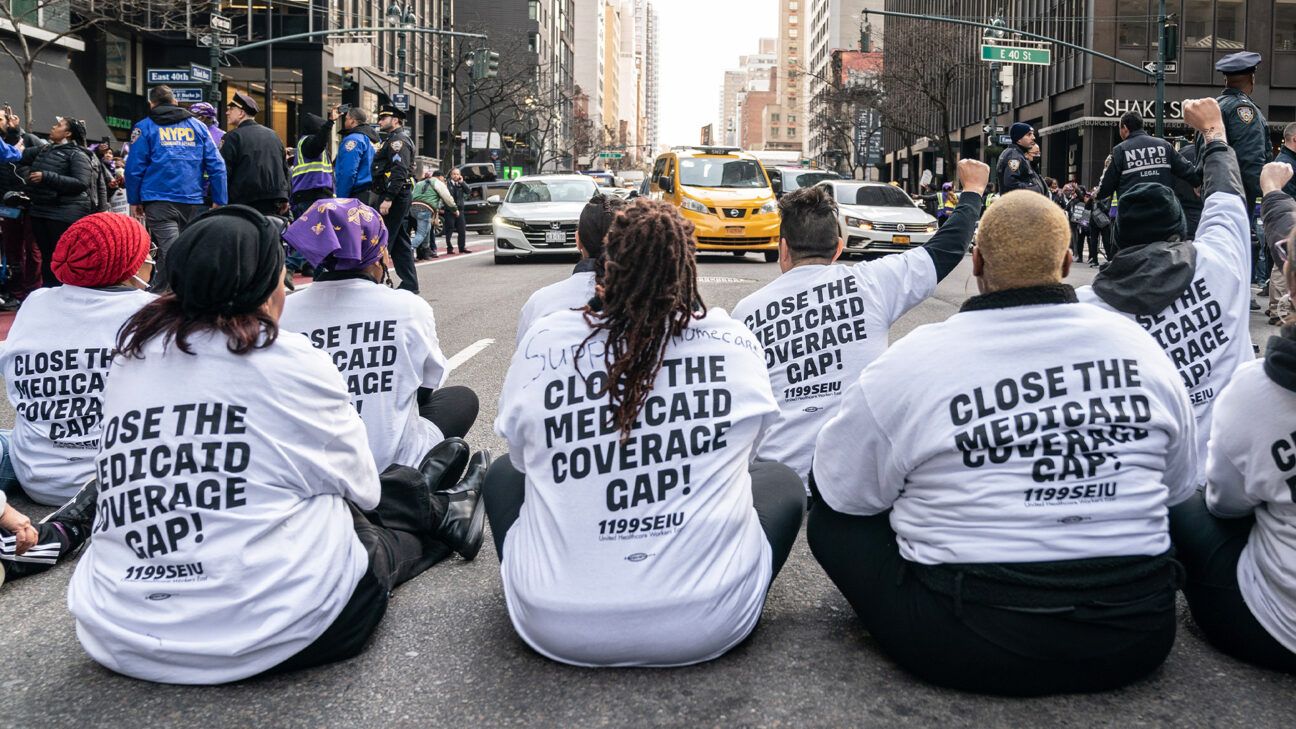
The state of healthcare has reached a critical stage in the United States, and issues such as the Affordable Care Act (ACA) and prescription drug prices are some of the focal points of this presidential election.
A research paper released by the Commonwealth Fund in mid-September reports that the U.S. ranks last among 10 developed nations in terms of healthcare. The report notes that, compared with the other nine nations studied, the United States experiences the most avoidable deaths, and more people die at younger ages.
Democratic presidential candidate Kamala Harris and Republican presidential candidate Donald Trump have starkly different approaches to solving the country’s biggest healthcare issues.
Many of Harris’s positions are listed on the issues page of her campaign website, while Trump’s can be found on his 20 Core Promises platform and Agenda 47 campaign sites.
To help clarify where each candidate stands on seven key healthcare issues as voters head to the polls, Healthline provides a summary of their positions and analysis by experts on how their different approaches could shape the future of healthcare.
Affordable Care Act (ACA)

The Affordable Care Act (ACA) was signed into law by former President Barack Obama in 2010. The program, commonly referred to as Obamacare, provides a marketplace for consumers to buy health insurance with relatively low monthly premiums.
It requires insurance companies to provide coverage to people with preexisting health conditions, including pregnancy, without additional charges. It also allows children to stay on their parents’ insurance coverage until they are 26 years old. It mandates that everyone have some sort of health insurance or face a financial penalty.
Where Kamala Harris stands
- Harris is a strong advocate for the ACA and has promised to expand and strengthen it.
- As a senator, Harris voted against then-President Trump’s attempts to repeal the law.
- She has stated she wants to make affordable healthcare a right, not a privilege.
- Under the Biden-Harris administration, the ACA reached record-high enrollment numbers in 2024, with more than 20 million people signed up for coverage.
- Harris supported President Joe Biden’s initiatives to expand the enrollment period and institute programs that allow people in lower-income households to purchase plans with little or even no monthly premiums.
- Some of these programs are scheduled to expire in 2025, and Harris has indicated she would try to renew them.
Where Donald Trump stands
- Trump tried to repeal the ACA on several occasions while he was president.
- Trump succeeded in reducing the penalty for not having health insurance to $0, providing people who didn’t want to purchase health insurance a way to do so without financial penalty.
- He increased the duration of short-term insurance plans from 3 months to 1 year. Those plans offered lower premiums but also had restrictions, such as denying coverage to people with preexisting conditions.
- Trump cut funding for marketing and outreach for ACA programs, leading to decreased enrollment.
- During the current campaign, Trump has promised to replace the ACA with a system that is “much better, stronger, and far less expensive.” However, he has not offered any specifics about how he would accomplish this other than stating he had “concepts of a plan” at the September 10 presidential debate.
What healthcare experts think of the candidates’ stances on the Affordable Care Act
Rosemarie Day, a health reform expert and the founder and CEO of Day Health Strategies, said that the Affordable Care Act has more popular support today than ever before due in large part to its protection of people with preexisting conditions, which is one of the law’s most popular provisions.
“Repealing the ACA would be extremely damaging to the health of millions of Americans who depend on its subsidized coverage through health insurance marketplaces and its protection of people with preexisting conditions,” Day said. “Millions of people would become uninsured. Uninsured people are more likely to die from their illnesses, many of which are preventable or manageable with adequate health coverage.”
Day said there is currently no politically acceptable framework for healthcare in the United States that will work as well as the ACA and that the law needs to be enhanced, not replaced.
“To that end, Kamala Harris is supporting the expanded marketplace subsidies that were enacted during the pandemic and extending them beyond 2025. This will help to ensure that those who have health insurance coverage today will be able to maintain that coverage, which will help them stay healthier,” Day said.
Kanwar Kelley, MD, is the co-founder and CEO of Side Health. He said that expanding the ACA would also allow for lower cost plans and decrease the gap in healthcare for people with lower incomes.
However, Kelley explained that Trump’s efforts to repeal aspects of the ACA during his presidency contributed to higher costs.
“Health insurance is subsidized by young and healthy members who utilize fewer health resources,” Kelley said. “During his presidency, Trump tried to strip the policy of the individual mandate, which had financial penalties for not having health insurance. With no penalty, many chose not to purchase insurance, which led to higher premiums for those seeking plans available under the ACA.”
He noted that Trump also cut funding for marketing and outreach, which decreased enrollment and led to reduced membership and high premiums.
“The ACA addresses health disparities by providing insurance to those otherwise locked out of coverage due to chronic illness or cost. With multiple attempts to repeal with no concrete plan, the Trump administration would risk millions of Americans losing their health insurance, increasing health disparities,” Kelley said.
Abortion

There may not be a hotter flashpoint issue in the 2024 presidential election than abortion.
The political heat was triggered in 2022 when the U.S. Supreme Court, in a case known as the Dobbs decision, upheld a restrictive Mississippi law on abortion and overturned the constitutional protections detailed in the court’s 1973 Roe v. Wade ruling.
In the 2 years since the Dobbs decision, 41 states have adopted abortion restrictions of some sort. Eleven of those states restricted abortion at the stage of fetal viability as defined in Roe v. Wade. Another 14 have restricted abortions after conception.
Where Kamala Harris stands
- She has said she would protect abortion rights by working with Congress to sign a law codifying the federal protections that existed under Roe v. Wade. Under that standard, states could restrict abortion only after fetal viability, which typically occurs between 23 and 25 weeks.
- Harris believes that the issue goes beyond a woman’s ability to access abortion services.
- She has noted that the restrictions currently in place have discouraged medical professionals from providing emergency care to those who have serious pregnancy complications for fear of being prosecuted under a state’s abortion restriction laws.
Where Donald Trump stands
- He has taken credit for removing the Roe decision from the books and praised the Supreme Court, including the three justices he appointed, for overturning it and placing the issue in the hands of state legislators.
- During Trump’s presidency, officials in the Department of Health and Human Services took away funding from more than 1,000 health centers that referred people for abortion services.
- He has dodged questions about whether he would veto a national abortion ban.
- Trump said he favors exceptions to abortion restrictions in cases of rape, incest, or when the life of the mother is at risk.
- He has criticized some of the most restrictive state laws, including one in his home state.
- However, he said he would be voting against a measure on the November ballot that would overturn Florida’s current law and prohibit laws that restrict abortions before fetal viability, generally considered to be between 22 and 24 weeks of pregnancy.
What healthcare experts think of the candidates’ stances on abortion
Day noted that “women’s health is being put at significant risk through not receiving abortion care and related health services.”
“Even women who are experiencing early signs of a miscarriage are experiencing delays in care in states with abortion bans due to doctors’ fears of being prosecuted for providing treatment that could be construed as performing an abortion,” she said.
This has galvanized many people to take action and could be a deciding factor in the 2024 election, as there are 10 states where abortion will be on the ballot, including several swing states.
“In every state where abortion has been on the ballot (seven so far), the side to protect women who need an abortion has prevailed,” Day said. “People are recognizing that they don’t need to support abortions to agree that government shouldn’t interfere with an individual’s freedom to protect their reproductive health.”
Despite this momentum, Day said there is a growing concern that conservatives will try to enact a national abortion ban. While Trump hasn’t committed to vetoing or supporting a national abortion ban, she said, “He has a profound lack of credibility with pro-choice voters on this issue.”
On the other hand, Day noted that Kamala Harris has vowed to support a national law to protect women who are seeking abortion care and has made a point of reaching out to women who are affected by this issue. She’s also connected with the grieving families of those who have lost a loved one due to a lack of abortion care.
“She has vowed to support a national law to protect women who are seeking abortion care,” Day said, who added that Harris is “exceptionally credible on this issue.”
Reproductive health

Reproductive health, including contraception and in vitro fertilization (IVF), are closely tied to the issue of abortion.
That was demonstrated in February when the Alabama Supreme Court ruled that frozen embryos created during the IVF process could be considered “children.”
Supporters of IVF said the decision could make fertility clinics less likely to provide IVF treatments because of fears they could be prosecuted if frozen embryos were damaged or destroyed.
The issue came to the forefront again in mid-September when Senate Republicans blocked a bill that would have provided a nationwide right to IVF treatments.
Where Kamala Harris stands
- She has said she will defend Americans’ rights to access contraception and fertility treatments.
- Harris believes the Alabama ruling was the direct result of the Supreme Court’s decision to overturn the protections under Roe v. Wade.
- After the Senate blocked the IVF bill, Harris released a statement criticizing “Republicans in Congress” for failing to “protect access to the fertility treatments many couples need to fulfill their dream of having a child.”
- On her Facebook page, Harris posted in May, “Contraception is health care, and every person in America should have the freedom to access the health care they need.”
Where Donald Trump stands
- He has recently stated that he wants to make IVF treatments free by either requiring insurance companies to cover the procedures or federally funding them, but he has not specified yet how such a program would be funded.
- In May, Trump said he was “open” to imposing regulations on access to contraception. A few days later, he clarified his position by saying he was against a ban on contraception but might still favor restrictions that make it more difficult to obtain them.
- He instituted some policies that reduced access to contraception during his presidency, including allowing more companies to opt out of birth control coverage in their workers’ health insurance plans.
What healthcare experts think of the candidates’ stances on reproductive health
Kelley said that while both Harris and Trump have signaled that they support opening access to IVF treatments, both camps are light on specifics on funding for the program and how the legislation would require insurance companies to cover the procedures.
“Despite their agreement in this area, logistically, IVF support may be challenging to implement as embryo-protective laws, like that in Alabama, could become more widespread with Republican leadership,” Kelley said.
He also noted that physicians are reluctant to provide treatments related to IVF in some states due to unclear regulations that open medical personnel and facilities to risk of litigation or, worse, criminal charges.
Additionally, Kelley said that reducing access to contraception will negatively affect lower income households by restricting their access to family planning materials. Without policies supporting expanded paid family leave and other family-friendly social programs, this could put extra stress on many families struggling in the current financial market.
“Contrary to this, the Harris campaign has championed reproductive health as fundamental healthcare, including the right to contraception and comprehensive reproductive care. By doing so, this would increase accessibility to care for women in low income or rural communities as well as minority populations,” Kelley said.
Learn more about how Harris and Trump differ on abortion and reproductive health with Healthline’s more expansive comparison here.
Maternal health

By most standards, the status of maternal healthcare in the United States is not where it should be.
A June 2024 report by the Commonwealth Fund states that the United States maternal mortality rate — 22 deaths per 100,000 pregnancies — is the highest among the 14 higher income countries it studied. In fact, the U.S. rate was 55% higher than the rate in Chile, the second highest nation on the list.
The report also notes that Black women in the United States have a maternal mortality rate more than double the country’s overall rate.
The report states that differences in health insurance coverage, as well as the use of midwives, contribute to the mortality rate. It also notes that the lack of paid family leave after the birth of a child is another contributing factor because it makes it more difficult for women to receive follow-up care for pregnancy complications.
According to a Centers for Disease Control and Prevention (CDC) study, 80% of U.S. maternity-related deaths are preventable.
Additionally, the United States is one of only six countries worldwide without national paid family or maternity leave. However, 13 states and the District of Columbia currently have laws mandating some sort of paid family or medical leave.
Where Kamala Harris stands
- She was out front when the Biden administration introduced policies this summer to improve maternal health, which included minimum safety standards for hospitals, training, emergency services readiness, and transfer protocols for obstetric patients.
- Harris also touted the fact that 47 states now offer Medicaid postpartum coverage for 12 months. Only three states offered such coverage in January 2021.
- She has promised to expand paid family leave to parents of newborns and people caring for sick loved ones.
- She has proposed increasing paid family leave nationwide for up to 6 months.
- Harris also promoted a $6,000 tax credit for parents of newborns.
Where Donald Trump stands
- As president, Trump signed legislation that provided up to 12 weeks of paid maternity and paternity leave to federal employees after the birth, adoption, or fostering of a child. However, the program did not cover paid leave for a person taking care of a sick relative, and it also did not cover workers in the private sector.
- He also signed a law in 2018 that provided $50 million in grants to states to develop maternal mortality review committees, promote a better understanding of maternal health complications, and identify solutions to help prevent maternal health issues.
- Currently, there is no mention of maternal health on either his Agenda 47 video page or his campaign platform page.
What healthcare experts think of the candidates’ stances on maternal health
Without specific policies and guidance, maternal health disparities will continue to grow, Kelley said.
“The Trump administration has not made maternal health one of the keystone factors of his previous presidency or current campaign. However, it was championed by his daughter Ivanka, as she detailed her struggle with postpartum depression. Ivanka is not involved in this campaign, so it is unclear who will lead the policy charge if Trump is reelected,” Kelley said.
On the other hand, Kamala Harris has been vocal on the campaign trail about maternal mortality, continuing the focal point she has as vice president.
“Harris has proposed initiatives such as implicit bias training, increased standards for hospitals in maternal health outcomes, and research into the race disparity in maternal mortality. She has also suggested increased access to doula and midwife support, possibly supporting those in lower income and rural areas,” Kelley said.
Additionally, he noted that Harris’s policy on extending Medicaid coverage during the postpartum period also increases access to mothers after giving birth.
While the Trump campaign has not directly addressed maternal health during this election cycle, his previous policies tangentially reduced access and availability of maternal healthcare.
Though it’s not clear what factors are contributing to the excessive maternal mortality crisis, Kelley noted that Harris has “directly attempted to address these issues with policies increasing access and length of care.”
Medicaid

The Medicaid program was approved in 1965 and is funded by federal and state governments.
States administer Medicaid programs but must follow federal standards. Each state has flexibility in determining who can receive coverage, how healthcare should be delivered, and how much medical professionals who provide services should get reimbursed.
According to health policy organization KFF, in 2021, Medicaid spending accounted for 27% of total state expenditures, second only to education programs. It also accounted for about 20% of personal healthcare spending in the United States.
The Affordable Care Act expanded Medicaid coverage to nearly all non-elderly adults with incomes up to 138% of the federal poverty level. That’s about $20,000 annually for an individual. So far, 41 states have opted in on this Medicaid expansion program.
Overall, the $800 billion public health insurance program now serves more than 90 million people with lower incomes across the country. That’s about 20% of the total population.
The program also provides services for people with disabilities, people in nursing homes, and people with mental health conditions. Medicaid also covers about 40% of all births in the United States.
It is separate from the Medicare program, which primarily provides healthcare services for people 65 years and older.
Where Kamala Harris stands
- She has supported and been involved in several Biden administration initiatives involving the Medicaid program.
- Since 2021, the White House has withdrawn work requirements for some Medicaid recipients in some states. However, a federal judge reinstituted the work requirements in Georgia’s Pathways program.
- In the past 4 years, Biden administration officials have taken steps to phase out Medicaid premium requirements that had been implemented in several states.
- The administration is also encouraging states to propose waivers that expand Medicaid coverage and improve continuity of care.
- If elected president, Harris is expected to require the states that have yet to adopt the Affordable Care Act’s Medicaid expansion to do so.
Where Donald Trump stands
- During the Trump presidency, administration officials promoted several changes in the Medicaid program, most of which the Biden administration has undone.
- One of the biggest changes was in work requirements. The Trump administration encouraged states to apply for Section 1115 waivers to condition Medicaid coverage on people meeting work and reporting requirements.
- Trump’s administration approved 13 state work requirement waivers. This was the first time work requirements had been implemented since Medicaid was approved in 1965.
- The Trump administration also approved a range of changes from states, including charging premiums up to 5% of family income, locking out enrollees who hadn’t paid premiums, and eliminating retroactive eligibility to new enrollees.
- In addition, the administration introduced a plan to give states extreme flexibility in using Medicaid funds to cover some adults without being restricted by federal standards.
- During the 2024 presidential campaign, Trump said he wouldn’t cut entitlement programs, including Medicaid.
- However, some Republican state leaders have expressed the hope that Trump will reinstitute waivers for Medicaid work requirements if elected to a second term.
What healthcare experts think of the candidates’ stances on Medicaid
Kelley said that Harris and Trump have fundamentally different visions for healthcare in the United States, particularly regarding affordable care and expanding access to more Americans.
“The Trump administration has tried to reduce spending on government programs, such as Medicaid and Medicare, by proposing eligibility requirements for coverage. This includes proof of employment, education, or volunteer work to remain on Medicaid,” Kelley said.
“However, introducing these requirements will affect lower income individuals disproportionately who are unable to participate in those activities due to disabilities, caregiving responsibilities, or living in rural areas,” he said.
Kelley also noted that Trump repeatedly endorsed repealing or replacing the ACA, which would have caused millions of Americans to lose coverage without other options.
If the ACA were to be repealed without a replacement, Kelley said that low income communities who depend on Medicaid as their primary healthcare would be disproportionately affected.
“The need for medical services will not decrease. [These consumers] will likely use emergency services, increasing uncompensated care and putting additional strain on health systems,” he said.
In contrast, Kelley said Harris’s policies focus on expanding and strengthening Medicaid and undoing restrictions put in place during the Trump administration.
“While not universal healthcare, giving greater access to Medicaid will allow lower income Americans to find care. Creating protections for preexisting conditions and additional subsidies will allow for better access to preventive medicine and other medical procedures,” Kelley said.
Prescription drug prices

People in the United States pay more for prescription drugs than just about any other place in the world.
A 2024 Rand study that used 2022 data reports that U.S. consumers paid 278% more for prescription drugs than 33 other countries.
The report also states that the gross price for brand-name originator drugs was 422% higher in the United States than elsewhere. Even after adjusting for manufacturer-funded rebates, brand-name prescriptions were still triple what people in other countries pay.
However, researchers note that U.S. consumers pay 33% less for unbranded generic drugs than consumers in other nations, but this does not fully offset the costs of brand-name prescriptions.
Insurance companies also pick up a significant portion of prescription drug costs, with consumers sometimes paying only a fraction of the actual cost.
Overall, retail prescription drug spending accounts for about 11% of personal healthcare services in the United States.
Where Kamala Harris stands
- She has noted that she took on the pharmaceutical industry when she was California’s attorney general.
- Harris has promised to build on the Biden administration’s success in reducing the cost of prescription drugs.
- She plans to extend to all Americans the $35 cap on insulin and the $2,000 cap on out-of-pocket spending now offered through Medicare to senior citizens.
- She supported the Biden administration’s decision to allow Medicare to negotiate drug prices with pharmaceutical companies.
- In the past, Harris has endorsed plans to ensure that people in the United States don’t pay more for the same prescription drugs as consumers in other countries.
- Harris supports “march in” rights, which allow the government to seize the patents of high priced drugs developed using federal research funds to make those prescriptions more affordable.
Where Donald Trump stands
- As president, Trump signed four executive orders in 2020 that targeted prescription drug prices.
- The first order directed federally qualified health centers to pass along discounts on insulin and epinephrine to lower income households.
- The second called for the safe and legal importation of prescription drugs from Canada and other countries where the price for identical medications is lower.
- The third order prohibited “secret deals” between drug manufacturers and pharmacy benefit managers to help ensure consumers directly benefit from available discounts.
- The fourth set out to ensure the United States pays the lowest price available among economically advanced countries for drugs covered under the Medicare Part B plan.
- Trump stated that in 2018, prescription drug prices recorded their largest annual price decrease in a half-century. However, numerous experts disputed that claim.
- In an Agenda 47 video, he said that if elected to a second term, he would plan to end the pharmaceutical shortages in the United States.
What healthcare experts think of the candidates’ stances on prescription drug prices
Trump and Harris agree on lowering prescription drug prices, and their campaign promises reflect that.
“Throughout various executive orders during his presidency, Trump aimed to reduce the cost of the most common pharmaceuticals used, primarily for Medicare recipients, to varying degrees of success,” Kelley said.
Kelley also pointed out that the Biden administration also passed prescription cost control measures as part of the Inflation Reduction Act, which allows the Department of Health and Human Services and Centers for Medicare & Medicaid Services to negotiate drug prices for 10 to 20 drugs per year. It’s projected to save billions over the next decade.
Harris’s policies mostly mirror these priorities.
Kelley noted that Trump has specifically targeted obtaining supplies from foreign companies and directing domestic companies to offer prices similar to those offered to other countries.
“In my practice, several patients admit to going across the border to obtain medication for lower prices. Being able to source from reliable companies in other countries would increase competition and pressure domestic pharmaceutical companies to lower prices,” Kelley said.
“Harris has focused on negotiating prices with companies and capping consumer costs in line with what was passed as part of the Inflation Reduction Act. While this may work on some of the most common and generic pharmaceuticals, newer, brand-name drugs may retain their pricing to offset company losses,” Kelley added.
Mental health

The CDC estimates that more than 1 in 5 U.S. adults live with a mental health condition.
It also notes that 1 in 5 young people 13 to 18 years old, either currently or at some point in their lives, have had a severe mental health condition.
In addition, the agency states that 1 in 25 U.S. adults live with a serious mental health condition, such as schizophrenia, bipolar disorder, or major depression.
Mental Health America reports that 1 in 4 U.S. adults with frequent mental distress are unable to see a medical professional due to cost, and about 10% of adults with a mental health issue are uninsured.
In addition, about 10% of adults and 8% of youth have private insurance that does not cover mental health.
Furthermore, a 2023 report states that more than half of the U.S. population lives in areas that have shortages of mental health professionals. Many of them tend to be reimbursed by insurance plans at lower rates than physical health providers.
Where Kamala Harris stands
- She has been involved in several White House programs to improve access to mental health care.
- In September 2024, the Biden administration unveiled a plan that places new requirements on health plans to improve and strengthen access to mental health care for 175 million Americans.
- Specifically, the plan requires insurance companies to make changes if they are providing inadequate access to care for mental health and substance use disorder.
- Among those requirements is that insurance companies evaluate their provider networks, how much they pay out-of-network providers, and how often they require or deny prior authorization for mental health services.
- The plan also states that insurance companies cannot use more restrictive prior authorization or narrower networks to make it more difficult for people to access mental health and substance use disorder benefits.
- The plan follows Harris’s announcement in January 2024 that the Biden administration was making an additional $285 million available to schools nationwide for hiring and training mental health counselors.
Where Donald Trump stands
- In 2019, Trump called for reforms to the nation’s mental health laws after school shootings in Texas and Ohio.
- The address was criticized by health policy advocates who said the statements stigmatized people with mental illness and were the wrong approach to the issue.
- Other experts pointed out that Trump’s plans to repeal the Affordable Care Act as well as allow individuals to stay in short-term insurance plans that often exclude mental health coverage for up to 12 months could also have a negative effect.
- They also said those policies could cause adults with lower incomes to lose health coverage that they might need to access mental health care.
- In 2023, Trump also called for the return of “mental institutions” to get homeless people off the streets.
- Trump has promised his administration would offer treatment and other resources for people with less serious mental health issues, but he would approach the issue differently for people with more serious mental health issues.
What healthcare experts think of the candidates’ stances on mental health
During his presidency, Trump focused his response on the opioid crisis and veteran mental health but failed to address mental health in the larger population, Kelley said.
“His most recent recommendation for the reinstitution of ‘mental institutions,’ to separate those dealing with mental health issues from the general population, will perpetuate the stigma of mental health by branding individuals. It is unclear how these institutions would be funded, if they would include government or private institutions, or how an individual would qualify to be admitted,” Kelley said.
He also noted that the Trump administration’s lack of a comprehensive mental health policy failed to address stigma and educate the public on mental health issues, and that the focus on specific populations left many without access to mental health treatment.
“Harris, however, has made mental health a focus of her public health initiatives. This includes maternal mental health and mental health in underserved communities. Specifically, she aims to extend Medicaid coverage postpartum to expand access to new mothers. This addresses the disparities in low income populations and minorities,” Kelley said.
Harris has also recommended addressing mental health in kids and teens by expanding mental health coverage in schools. This is another area in which increased access could reduce potential mental health crises, Kelley said.
